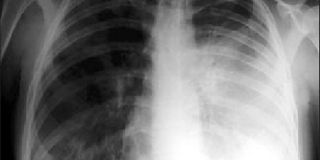Pneumonic plague outbreak kills one

Chest Radiograph of Patient With primary pneumonic plague
What you need to know:
- Mr Andrew Kajoyingi, the Resident District Commissioner, said communities should clear the bushes around their homes to avoid the rodents from breeding.
Zombo. An outbreak of the pneumonic plague infection has left one dead in Zombo District, health officials have confirmed.
The disease had been wiped out four years ago, according to a source from the Uganda Virus Institute regional centre in Arua, where four people were reported dead.
The Ministry of Health confirmed two cases of pneumonic plague patients, who were recently admitted to the district referral hospital before a lady, Ms Jennifer Ngamita, succumbed to the disease.
The Public Health consultant from the Ministry of Health, Dr George Openjtho, has now camped in the district.
He said blood samples taken from Ms Ngamita tested positive.
Efforts
“We are still monitoring the situation of another patient because we want to do enough sensitisation in the communities to prevent further spread,” he said on Tuesday.
The disease is believed to have spread from the neighbouring DR Congo, where there is little surveillance and a broken health system.
Preliminary investigations by the health team, indicate that the deceased attended the burial of her relatives in DR Congo, who were suspected to have died of the disease.
Ministry of Health has already dispatched emergency drugs.
The District Health Officer, Mr Sam Ajoga, said they are starting a massive vaccination programme in the communities because the plague, if not contained early, can have devastating effects.
He said people should report early symptoms such as flu that presents itself in a period of three to seven days.
Recently, during the re-equipping of the Uganda Virus Research Institute in Arua, the assistant District Health Officer for Arua, who had been engaged in the fight against the plague in Arua and Zombo, Mr Manasse Anziku, said: “We had a difficult time treating plague in the communities. The last cases of plague were reported three years ago.
This modern laboratory will help us in having quick diagnosis and management of any type of virus when it is detected earlier in the laboratory. We used to send the samples to Entebbe, which usually took long for results to reach us.”
Solutions
Mr Andrew Kajoyingi, the Resident District Commissioner, said communities should clear the bushes around their homes to avoid the rodents from breeding.
“People should practice good hygiene. Even the food they leave should be covered because rats like eating food left-overs which humans consume after. This would cause more problems when not kept properly,” he said.
BACKGROUND
According to World Health Organisation, Plague is an infectious disease caused by the bacteria Yersinia pestis, a zoonotic bacteria, usually found in small mammals and their fleas.
It is transmitted between animals from their fleas. Humans can be contaminated by the bite of infected fleas, through direct contact with infected materials or by inhalation.
Pneumonic plague, the first signs of illness are fever, headache, weakness and rapidly developing pneumonia with shortness of breath, chest pain, cough and sometimes bloody or watery sputum.
The statistics of 2008 from neighbouring Arua health office indicate that 90 cases were recorded with 17 deaths.
During the dry seasons, plague outbreak was recorded annually in the district.



